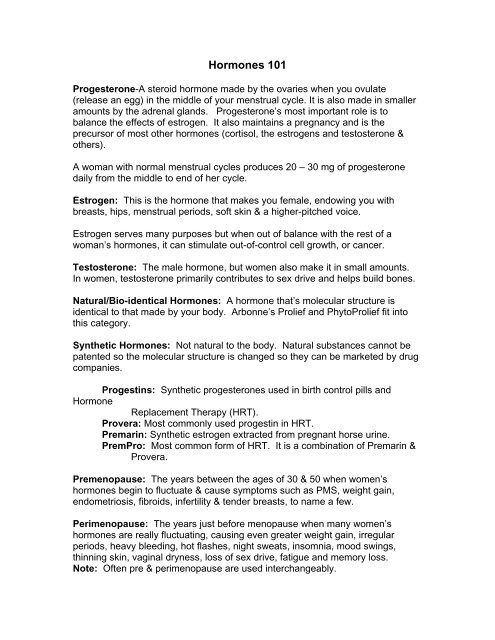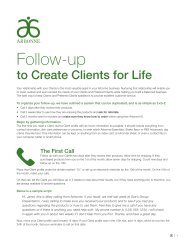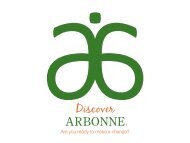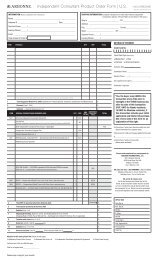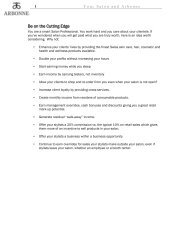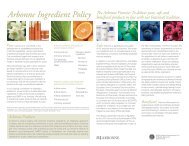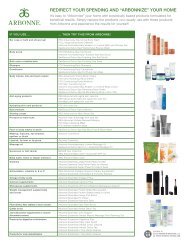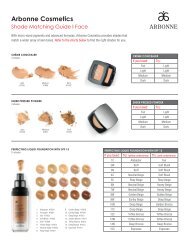Hormones 101
Hormones 101
Hormones 101
Create successful ePaper yourself
Turn your PDF publications into a flip-book with our unique Google optimized e-Paper software.
<strong>Hormones</strong> <strong>101</strong><br />
Progesterone-A steroid hormone made by the ovaries when you ovulate<br />
(release an egg) in the middle of your menstrual cycle. It is also made in smaller<br />
amounts by the adrenal glands. Progesterone’s most important role is to<br />
balance the effects of estrogen. It also maintains a pregnancy and is the<br />
precursor of most other hormones (cortisol, the estrogens and testosterone &<br />
others).<br />
A woman with normal menstrual cycles produces 20 – 30 mg of progesterone<br />
daily from the middle to end of her cycle.<br />
Estrogen: This is the hormone that makes you female, endowing you with<br />
breasts, hips, menstrual periods, soft skin & a higher-pitched voice.<br />
Estrogen serves many purposes but when out of balance with the rest of a<br />
woman’s hormones, it can stimulate out-of-control cell growth, or cancer.<br />
Testosterone: The male hormone, but women also make it in small amounts.<br />
In women, testosterone primarily contributes to sex drive and helps build bones.<br />
Natural/Bio-identical <strong>Hormones</strong>: A hormone that’s molecular structure is<br />
identical to that made by your body. Arbonne’s Prolief and PhytoProlief fit into<br />
this category.<br />
Synthetic <strong>Hormones</strong>: Not natural to the body. Natural substances cannot be<br />
patented so the molecular structure is changed so they can be marketed by drug<br />
companies.<br />
Progestins: Synthetic progesterones used in birth control pills and<br />
Hormone<br />
Replacement Therapy (HRT).<br />
Provera: Most commonly used progestin in HRT.<br />
Premarin: Synthetic estrogen extracted from pregnant horse urine.<br />
PremPro: Most common form of HRT. It is a combination of Premarin &<br />
Provera.<br />
Premenopause: The years between the ages of 30 & 50 when women’s<br />
hormones begin to fluctuate & cause symptoms such as PMS, weight gain,<br />
endometriosis, fibroids, infertility & tender breasts, to name a few.<br />
Perimenopause: The years just before menopause when many women’s<br />
hormones are really fluctuating, causing even greater weight gain, irregular<br />
periods, heavy bleeding, hot flashes, night sweats, insomnia, mood swings,<br />
thinning skin, vaginal dryness, loss of sex drive, fatigue and memory loss.<br />
Note: Often pre & perimenopause are used interchangeably.
PHYSIOLOGICAL EFFECTS OF ESTROGEN AND PROGESTERONE<br />
Estrogen Effects<br />
Progesterone Effects<br />
Message is to grow & multiply<br />
Breast cell stimulation (fibrocystic breasts)<br />
Increased body fat and weight gain<br />
Salt and fluid retention<br />
Causes depression & headaches<br />
Cyclical migraines<br />
Poor sleep patterns<br />
Interferes with thyroid hormone function<br />
Impairs blood sugar control<br />
Increased risk of blood clots<br />
Decreases sex drive<br />
Reduced oxygen levels in all cells<br />
Causes endometrial cancer<br />
Increased risk of breast cancer<br />
Increased risk of prostate cancer<br />
Restrains bone loss<br />
Triggers autoimmune diseases<br />
Slow growth & mature normally<br />
Protects against breast fibrocysts<br />
Helps use fat for energy<br />
Natural diuretic<br />
Acts as natural anti-depressant<br />
Prevents cyclical migraines<br />
Promotes normal sleep patterns<br />
Facilitates thyroid hormone function<br />
Helps normalize blood sugar levels<br />
Normalizes blood clotting<br />
Restores sex drive<br />
Restores proper cell oxygen levels<br />
Prevents endometrial cancer<br />
Helps prevent breast cancer<br />
Decreased risk of prostate cancer<br />
Stimulates new bone formation<br />
Prevents autoimmune diseases<br />
The list above is not all-inclusive.
Phytoestrogens: Another word for plant estrogen. Can be useful because they<br />
behave like weak-acting estrogens and do occupy estrogen receptors so they<br />
can protect against excess estrogen coming from the environment or from within<br />
the body. Some women have been able to treat menopausal symptoms such as<br />
hot flashes and vaginal dryness with phytoestrogens alone.<br />
Xenoestrogens: Another name for a foreign, man-made estrogen that has toxic<br />
estrogen effects on the human body. Xenoestrogens can be very potent and<br />
toxic and tend to accumulate in the body. Examples are: pesticides, plastics,<br />
acetones (nail polish remover), perfumes, hair sprays, body lotions, industrial<br />
waster products, exhaust, meats, soaps, carpeting, furniture, paneling, solvents<br />
in cleaners and many others. Symptoms of exposure to xenoestrogens include<br />
sinus problems, headaches, dry eyes, asthma & even cold hands and cold feet.<br />
Over time the exposure can cause arthritis, premenopausal symptoms and have<br />
been linked to many cancers.<br />
Estrogen Dominance: This describes a condition where a woman can have<br />
deficient, normal or excessive estrogen, but doesn’t have the correct amount of<br />
progesterone to balance its effects in the body. This is the most common form<br />
of hormonal imbalance.<br />
Symptoms of Estrogen Dominance:<br />
• Acceleration of the aging process<br />
• Allergies, including asthma, hives, rashes, sinus congestion<br />
• Autoimmune disorders such as lupus erythematosis and thyroiditis, and<br />
possibly Sjoegren's disease<br />
• Breast cancer<br />
• Breast tenderness<br />
• Cervical dysplasia (often leads to hysterectomy)<br />
• Cold hands and feet as a symptom of thyroid dysfunction<br />
• Copper excess<br />
• Decreased sex drive<br />
• Depression with anxiety or agitation<br />
• Dry eyes<br />
• Early onset of menstruation<br />
• Endometrial (uterine) cancer<br />
• Fat gain, especially around the abdomen, hips and thighs<br />
• Fatigue<br />
• Fibrocystic breasts<br />
• Foggy thinking<br />
• Gallbladder disease<br />
• Hair Loss<br />
• Headaches<br />
• Hot Flashes
• Hypoglycemia<br />
• Increased blood clotting (increasing risk of strokes)<br />
• Infertility<br />
• Irregular menstrual periods<br />
• Irritability<br />
• Insomnia<br />
• Magnesium deficiency<br />
• Memory loss<br />
• Mood swings<br />
• Osteoporosis<br />
• Polycystic ovaries<br />
• Pre-menopausal bone loss<br />
• PMS<br />
• Prostate cancer<br />
• Sluggish metabolism<br />
• Thyroid dysfunction mimicking hypothyroidism<br />
• Uterine cancer<br />
• Uterine fibroids<br />
• Water retention, bloating<br />
• Zinc deficiency<br />
How to Balance your <strong>Hormones</strong> Holistically:<br />
Focus on your diet:<br />
• Limit refined and highly processed foods. Instead, eat fruits, vegetables<br />
and whole grains. Vegetables contain phyto-chemicals and have many<br />
health supporting effects on the body.<br />
• Kick the sugar habit.<br />
• Drink 8-10 glasses of purified water. Avoid drinking 30 minutes before<br />
and after a meal. Water dilutes your enzymes which break down your<br />
food for nutrition to the cells.<br />
• When possible, buy organic. Organic foods are a key in hormone<br />
balance. They are void of heribicides, pesticides & chemical fertilizers.<br />
Organic meat and dairy products contain no antibiotics or hormones.<br />
• Take a high quality supplement with anti-oxidants since they help<br />
counteract xenoestrogens. Look for cold-pressured and those that<br />
dissolve quickly.<br />
• Eat a high fiber diet. Fiber works as a broom and sweeps toxins<br />
(xenoestrogens from the colon). Fiber binds to toxins like unbound<br />
estrogens and eliminates them from the body so they aren’t reabsorbed.<br />
Lower your stress. Stress depletes our progesterone stores and cause<br />
estrogen to dominate.
Exercise. Not only does exercise minimize stress but it also minimizes body<br />
fat which is a known storehouse for estrogen in our body.<br />
Use natural hormonal supplements. Supplementing with natural<br />
progesterone helps counteract harmful estrogenic effects and replenishes<br />
depleted progesterone stores. Both of these help improve and prevent<br />
estrogen dominance.<br />
Be a label reader & be aware of xenoestrogens. Many of our personal<br />
care & cosmetic products contain synthetic fragrances and petroleum<br />
products which are absorbed by our bodies. Room deodorizers, plastics,<br />
cleaners and many every day products contain harmful estrogenic<br />
compounds.<br />
Tidbits:<br />
The World Health Organization, recommends testing saliva levels, not blood<br />
serum levels for active hormone levels.<br />
Average age of menopause is 50.<br />
Menopause is NOT a disease state. Most of the “symptoms” of menopause are<br />
actually symptoms of hormonal imbalance.<br />
Just a few years ago, most women over 50 were placed on hormone<br />
replacement therapy or HRT. This practice slowed down the results of the<br />
Women’s Health Initiative (WHI) were released and showed that conventional<br />
HRT can significantly increase the risk of heart disease, stroke and breast cancer<br />
thus suggesting HRT could be dangerous. The WHI was stopped after only 5<br />
years because of these results.<br />
There are no known side effects of natural progesterone when taken at the 20<br />
milligram a day dose.
Resources:<br />
What Your Doctor May Not Tell You About Premenopause: Balance Your<br />
<strong>Hormones</strong> and Your Life From Thirty to Fifty, Dr. John Lee, MD et al<br />
What Your Doctor May Not Tell You About Menopause: The Breakthrough Book<br />
on Natural Hormone Balance, Dr. John Lee, MD et al<br />
The Estrogen Alternative: Natural Hormone Therapy with Botanical<br />
Progesterone, Raquel Martin with Judi Gerstung, DC<br />
What Your Doctor May Not Tell You About Breast Cancer: How Hormone<br />
Balance Can Help Save Your Life, Dr. John Lee, MD et al<br />
Hormone Heresy: What Women MUST Know About Their <strong>Hormones</strong>, Sherill<br />
Selman<br />
Dr. John Lee’s Hormone Balance Made Simple: The Essential How-to Guide to<br />
Symptoms, Dosage, Timing, and More, Dr. John Lee, MD with Virginia Hopkins<br />
Hormone Balance: A Matter of Life and Health, Kristine Klitzke, RN, BSN<br />
These materials have been compiled by and Arbonne Independent<br />
Consultant and are NOT OFFICIAL materials prepared or provided by<br />
Arbonne International, LLD. This is not intended to be a medical<br />
recommendation. The products offered on Arbonne.com are not offered<br />
for diagnosis, cure, mitigation, treatment or prevention of any disease or<br />
disorder nor have any statements herein been evaluated by the Food and<br />
Drug Administration (FDA). We strongly encouraged our customers to<br />
discuss topics of concern with their health care professionals.


